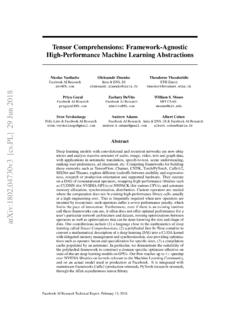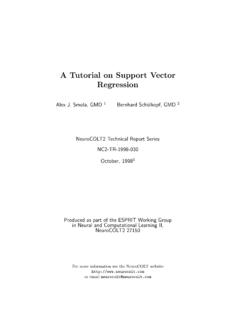Transcription of The Incorporation of Animal-Assisted Interventions in ...
1 The Incorporationof Animal-Assisted Interventionsin Social Work EducationPhilip Tedeschi, MSSW, LCSWJ ennifer Fitchett, MSWC hristian E. Molidor, PhD, MSW, social work practice requires orientation to di-verse social and cultural characteristics which structure the frameworkfor our communities and families. This paper explores the necessity ofincorporating the connection between people and non-human relation-ships in our understanding of social support systems. Specifically, weexamine our relationships with animals in the understanding of these so-cial networks and in turn, the readiness of social work education to sup-port this valuable and prominent feature of the modern family system. Inaddition, this paper will highlight the congruence between the study ofthe human-animal bond and the social work curriculum.[Article copiesavailable for a fee from The Haworth Document Delivery Service: 1-800-HAWORTH.]
2 E-mail address: Website: < > 2005 by The Haworth Press, Inc. All rights reserved.] , Animal-Assisted therapy, social work, socialwork education, social work curriculum, human-animal bond, socialsupport, family dynamicsPhilip Tedeschi is Assistant Professor; Jennifer Fitchett is Faculty Adjunct; andChristian E. Molidor is Associate Professor, Associate Dean and MSW Director; theUniversity of Denver Graduate School of Social Work, Denver, correspondence to: Philip Tedeschi, Graduate School of Social Work, TheUniversity of Denver, 2148 South High Street, Denver, CO 80208 (E-mail: of Family Social Work, Vol. 9(4) 2005 Available online at 2005 by The Haworth Press, Inc. All rights more than ever, effective social work practice requires orien- tation to diverse and unique qualities in the social and cultural makeupof our communities and families.)
3 When we have studied the underlyingconcept of social systems historically, our explorations were often lim-ited to how people are linked or attached. It seems the most importantquality of social support systems is that they establish and convey a use-ful interdependence and respect. The quality of these relationships pro-vides a sense of feeling valued, looked after, loved, even facilitatingsafety and attachment. Primary social connections are most often a de-scription of the relationships in our lives that are most paper explores the importance of incorporating the significantties between people and nonhuman relationships in our understandingof social support systems. Specifically, we must critically examine ourrelationships with companion animals in the understanding of these so-cial networks, and in turn, the readiness of social work education to sup-port this valuable and prominent feature of the modern family addition, this paper highlights the congruence between the study ofthe human-animal bond and social work relationship between people and animals holds a unique meaningto the field of social work.
4 Social work education, as in many professions,evolved out of the needs and pioneering efforts of practitioners and re-tains its meaning by staying close to the practice community. Socialwork education is often challenged by the difficulty of keeping pacewith the changing demands of practice skills and settings. Because theyare two aspects of a whole, the validity of education and practice are re-duced when they are not in reference to one another. Decisions regard-ing the development of social work education should therefore makeevery effort to take into consideration, and even make central, the cur-rent developments in the field of SOCIAL WORKS ocial work s core understanding of systems and defining focus onperson-in-environment are two of the central concepts shaping socialwork curriculum and practice. Our relationship with animals is an endur-ing feature in so many families, homes, and communities.
5 For centuries,the importance of animals in people s lives has been recognized (Bustad,1996). It is estimated that there are over 2,500 Animal-Assisted programsin the United States (Benda & Lightmark, 2004). Animal-Assisted ther-apy (AAT) is defined as a goal-directed intervention in which an animal60 JOURNAL OF FAMILY SOCIAL WORK that meets specific training and safety criteria is incorporated as an inte-gral part of the clinical healthcare treatment process ( About animal-as-sisted activities, ). AAT is delivered or directed by a professionalhealth or human service provider who demonstrates skill and expertiseregarding the clinical applications of human-animal Social Work (AASW)and the Mission of Social Work EducationThe strong emergence of Animal-Assisted Interventions is based pri-marily on the reliable beneficial effect that animals have on humanhealth, well-being, and motivation.
6 These notable effects can be demon-strated across age, race, gender, sexual orientation, socioeconomic sta-tus, and life condition. Images of animals appear in literature of allkinds art, celebrations, dreams, fables, folklore, language, medicine,music, religion, work, and recreation. Animals themselves can be foundin nearly every aspect of life. Social work educators have a responsibil-ity to consider the applicability of this topic to support the academicmission of social work education Graduate School of Social Work (GSSW) at the University ofDenver has offered a course, entitledIntegration of Animals into Thera-peutic Settingsfor the last six years, and now also offers a secondadvanced course, entitledAnimal-Assisted Social Work Practice. Origi-nally suggested by a group of GSSW students, the courses offer concen-tration-year students the opportunity to explore the therapeutic use ofhuman-animal interactions.
7 The courses expose students to practiceguidelines for Animal-Assisted activities (AAA) and animal-assistedtherapy (AAT), integrating national standards of care, proper safety,and ethical guidelines for animals and clients, experiential and alterna-tive therapy theory, and knowledge and skills into students core clini-cal training. The mission of the University of Denver Graduate Schoolof Social Work is to foster social responsibility and enhance the qualityof life, based on equality for all people, through excellence in teaching,scholarship, and leadership. The philosophy and core values of GSSW,which guide the developing curriculum and planning programs, includeprogressive ideals of social and economic justice, cultural diversity, andfreedom ( Our mission, ).GSSW s guiding principles enable graduates to analyze social prob-lem dynamics in individuals, families, organizations, communities, andsocial policy.
8 AASW lends itself to interdisciplinary coordination ineach of these areas and can be introduced into a number of therapeuticTedeschi, Fitchett, and Molidor61settings (with individuals, groups and families) in diverse populations receiving social work services are those who haveminimal positive experiences in their lives. Put as simply as possible,when introduced properly into a therapeutic setting, animals make peo-ple feel good, improve quality of life and assist in healing. For individu-als with a troubled history of human interactions, an AAT animal canserve as a nonthreatening partner in the treatment and support process,creating an initial trust connection that later may be transferred to theprofessional. The quiet, calm presence of an animal in a therapeutic sit-uation with those who have experienced trauma can remediate some ofthe episodes effects, enabling the individual to benefit more from theintervention.
9 In addition, an animal s loyalty and authentic nonjudg-mental willingness makes our relationships with them some of the mostenduring and safe interactions possible. AASW is a powerful therapeu-tic approach that can have multiple impacts, aiding in physical, socialand emotional healing through a dynamic of relationship and connectionwith people who are in difficult life situations, pets can be of specialbenefit. Studies investigating the measurable physical effects of hu-man-animal interaction have determined that they are effective in reducingblood pressure (Katcher, 1981; Serpell, 1990; Anderson, Reid & Jennings,1992) and promoting survival in coronary artery illness (Friedmann,Katcher, Lynch & Thomas,1980; Jennings, 1997). Animals can oftenreach people when human relationships may be difficult. When utilizedin an adjunct capacity, Animal-Assisted therapy has been found to fostersocialization, increase responsiveness, facilitate mental alertness, andenhance an outward focus on the environment (Fritz, Thomas, Kass &Hart, 1995; Holcomb & Meacham, 1998).
10 Modern culture has rekindled acceptance of animals as importantcontributors to our lives, supported by an encouraging array of multi-disciplinary endorsements for the therapeutic efficacy of animals in hu-man health, which now suggests legitimacy for the inclusion of animalsin therapeutic settings. The potential contribution of animals in humanhealth and well-being may help avoid an over-dependency on westernculture and promote valuable cross-cultural diversity (Serpell, 1994).Utilizing Animal-Assisted therapy allows socialworkers to interact withpeople experientially, rather than relying strictly on verbal understand-ing of families, individuals, and groups that may be lost, literally, OF FAMILY SOCIAL WORKANIMAL-ASSISTED SOCIAL WORKIN CLINICAL PRACTICE CONCENTRATIONSThe University of Denver organizes its graduate academic curricu-lum to meet accreditation standards and focus on important core educa-tional areas.


![[Mullender 85] - ontolinux.com](/cache/preview/f/4/4/7/3/6/1/2/thumb-f447361201cf19ddd8929be42c5e8213.jpg)

